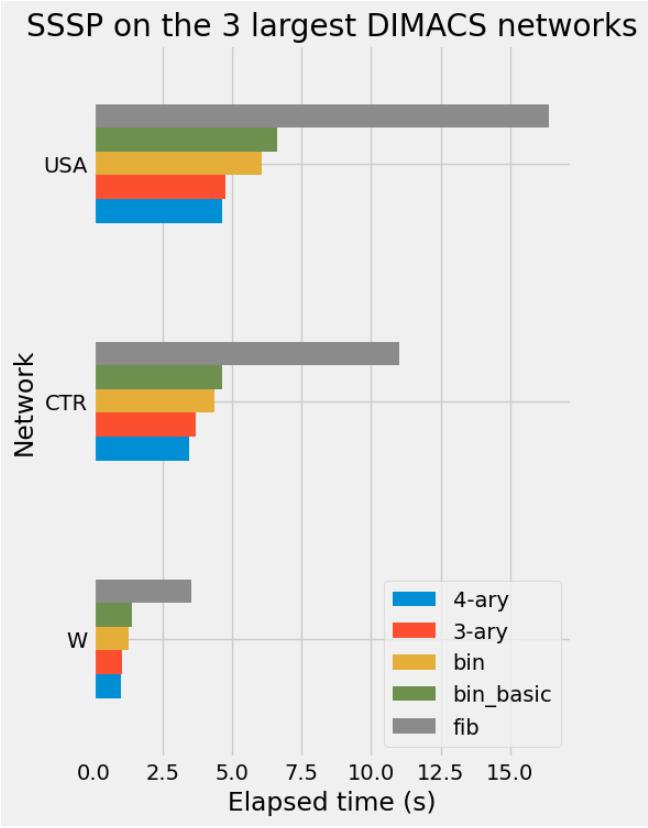Dijkstra's algorithm in Cython, part 2/3
This post is the second part of a three-part series. In the first part, we looked at the Cython implementation of Dijkstra’s algorithm. In the current post, we are going to compare different priority queue implementations, using Dijkstra’s algorithm on some road networks.
We apply the shortest path algorithm to the DIMACS road networks that we downloaded in a previous post: Download some benchmark road networks for Shortest Paths algorithms .
The implementation of Dijkstra’s algorithm is the one described in the first part: Dijkstra’s algorithm in Cython, part 1/3. The second approach is used, in which the priority queue is initialized with only the source vertex element.
Each priority queue is based on a slightly different heap. Here is a table with the different heaps that we are going to compare:
| priority queue label | heap | optimization | d-ary heap |
|---|---|---|---|
| bin_basic | binary | no | yes |
| bin | binary | yes | yes |
| 3-ary | 3-ary | yes | yes |
| 4-ary | 4-ary | yes | yes |
| fib | Fibonacci | N.A. | no |
Here is a definition of d-ary heaps from wikipedia:
The d-ary heap or d-heap is a priority queue data structure, a generalization of the binary heap in which the nodes have d children instead of 2. Thus, a binary heap is a 2-heap, and a ternary heap is a 3-heap
So we refer to the binary heap as one of the d-arry heaps.
The optimization designates a small change in the _min_heapify part of the d-ary heaps. We will describe it in the second section of this post.
All these priority queues derive from the one described in the previous post: A Cython implementation of a priority queue, except the one based on a Fibonacci heap. The priority queue based on a Fibonacci heap is taken from the AequilibraE repository. AequilibraE is a Python package for transportation modeling. This priority queue was originally developed by Jake VanderPlas, and is part of the SciPy library.
The bin_basic priority queue is exacly the one presented in the post: A Cython implementation of a priority queue.
d-ary heaps
We implement the d-ary heaps as a slight modification of the binary heap. The only lines that are changed are located in the _min_heapify and _decrease_key_from_node_index functions. In a d-ary heap, a parent node has d children, so we need to change:
- the access to a parent from a child (
_decrease_key_from_node_index) - the loop on child nodes from a parent node (
_min_heapify). We need to check d child nodes, and not just 2, in order find the child node with min key value.
For a node with index i, the parent is found at index (i - 1) // d. The child nodes of i are the nodes d * i + 1, …, d * i + d.
The _min_heapify optimization
Let’s start by showing the code of the _min_heapify function in the bin_basic priority queue:
cdef inline void _min_heapify(
PriorityQueue* pqueue,
size_t node_idx) nogil:
"""Re-order sub-tree under a given node (given its node index)
until it satisfies the heap property.
input
=====
* PriorityQueue* pqueue : priority queue
* size_t node_idx : node index
"""
cdef:
size_t l, r, i = node_idx, s
while True:
l = 2 * i + 1 # left child
r = l + 1 # right child
if (
(l < pqueue.size) and
(pqueue.Elements[pqueue.A[l]].key < pqueue.Elements[pqueue.A[i]].key)
):
s = l
else:
s = i
if (
(r < pqueue.size) and
(pqueue.Elements[pqueue.A[r]].key < pqueue.Elements[pqueue.A[s]].key)
):
s = r
if s != i:
_exchange_nodes(pqueue, i, s)
i = s
else:
break
We can observe that we always have r > l, since r = l + 1. So we do not need to check if l < pqueue.size if we know that r < pqueue.size. This saves us from a few if statements. This means that the while loop can be rewritten in the following way:
while True:
l = 2 * i + 1 # left child
r = l + 1 # right child
s = i
val_min = pqueue.Elements[pqueue.A[s]].key
if (r < pqueue.size):
val_tmp = pqueue.Elements[pqueue.A[r]].key
if val_tmp < val_min:
s = r
val_min = val_tmp
val_tmp = pqueue.Elements[pqueue.A[l]].key
if val_tmp < val_min:
s = l
else:
if (l < pqueue.size):
val_tmp = pqueue.Elements[pqueue.A[l]].key
if val_tmp < val_min:
s = l
Also, we are using two DTYPE_t variables: val_min and val_tmp. A similar optimization is applied to the different d-ary heaps.
Results
Package versions:
Python version : 3.10.8
cython : 0.29.32
numpy : 1.23.5
Computations are performed on a laptop with an 8 cores Intel i7-7700HQ CPU @ 2.80GHz, running Linux. Similarly to the first part of the post series, we checked the result against SciPy, only measured the execution time of the run phase (not the setup phase), and use the best time over 3 runs. We used the 3 largest DIMACS networks in order to get some significant elapsed time. Here are the features of these 3 networks:
| Network | vertex count | edge count |
|---|---|---|
| W | 6262104 | 15119284 |
| CTR | 14081816 | 33866826 |
| USA | 23947347 | 57708624 |

We see that the optimization of the _min_heapify only brings small benefits. Improvements due to the 3-ary or 4-ary heaps as compared to the binary heap is also of small magnitude, but still significant. Finally, we observe a clear advantage of the d-ary heaps over the Fibonacci one for this kind of networks, which might be due to a different underlying data structure.